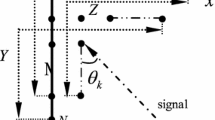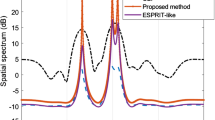Abstract
Direction of Arrival (DOA) estimation is one of the major tasks in array signal processing. In this paper, a new DOA estimation method is proposed using a rotational uniform linear array (RULA) consisting of omnidirectional sensors. The main contribution of the proposed method is that the number of distinguishable signals is larger than the methods in the literature with a uniform linear array consisting of the same number of omnidirectional sensors. Moreover, the new method can effectively reduce unknown spatial noises using a generalized complement projection matrix under the RULA framework. Simulations are presented to illustrate the effectiveness of the proposed method and comparison with some existing DOA estimation methods is also made.









Similar content being viewed by others
Notes
Here \(\mathbb {C}^{N \times K}\) denotes the set of complex matrices of dimension \(N\times K\) and \(\mathbb {C}^N=\mathbb {C}^{N \times 1}\) the set of complex vectors of dimension N.
References
Cao, M.-Y., Huang, L., Qian, C., Xue, J.-Y., & So, H. (2015). Underdetermined DOA estimation of quasi stationary signals via Khatri Rao structure for uniform circular array. Signal Processing, 106, 41–48.
Chevalier, P., Albera, L., Ferréol, A., & Comon, P. (2005). On the virtual array concept for higher order array processing. IEEE Transactions on Signal Processing, 53(4), 1254–1271.
Chevalier, P., & Férréol, A. (1999). On the virtual array concept for the fourth-order direction finding problem. IEEE Transactions on Signal Processing, 47(9), 2592–2595.
Chevalier, P., Ferréol, A., & Albera, L. (2006). High-resolution direction finding from higher order statistics: The 2q-MUSIC algorithm. IEEE Transactions on Signal Processing, 54(8), 2986–2997.
Donoho, D. L. (2006). Compressed sensing. IEEE Transactions on Information Theory, 52(4), 1289–1306.
Feng, D., Bao, M., Ye, Z., Guan, L., & Li, X. (2011). A novel wideband DOA estimator based on Khatri Rao subspace approach. Signal Processing, 91(10), 2415–2419.
Figueiredo, M. A., Nowak, R. D., & Wright, S. J. (2007). Gradient projection for sparse reconstruction: Application to compressed sensing and other inverse problems. Journal of Selected Topics in Signal Processing, 1(4), 586–597.
Grant, M., Boyd, S., Ye, Y. (2008). Cvx: Matlab software for disciplined convex programming.
Gurbuz, A. C., Cevher, V., & McClellan, J. H. (2012). Bearing estimation via spatial sparsity using compressive sensing. IEEE Transactions on Aerospace and Electronic Systems, 48(2), 1358–1369.
Han, F.-M., & Zhang, X.-D. (2005). An ESPRIT-like algorithm for coherent DOA estimation. Antennas and Wireless Propagation Letters, 4, 443–446.
Haupt, J., & Nowak, R. (2006). Signal reconstruction from noisy random projections. IEEE Transactions on Information Theory, 52(9), 4036–4048.
Isaacs, J. T., Quitin, F., Garcia Carrillo, L. R. Madhow, U., Hespanha, J. P. (2014). Quadrotor control for rf source localization and tracking. In Unmanned Aircraft Systems (ICUAS), 2014 International Conference on, IEEE, pp. 244–252.
Kaveh, M. & Bassias, A. (1990). Threshold extension based on a new paradigm for MUSIC-type estimation. In International Conference on Acoustics, Speech, and Signal Processing. ICASSP-90., IEEE, pp. 2535–2538.
Kaveh, M., & Barabell, A. (1986). The statistical performance of the MUSIC and the minimum-norm algorithms in resolving plane waves in noise. IEEE Transactions on Acoustics, Speech, and Signal Processing, 34(2), 331–341.
Lavate, T. B., Kokate, V., Sapkal, A. (2010). Performance analysis of MUSIC and ESPRIT DOA estimation algorithms for adaptive array smart antenna in mobile communication. In Second International Conference on Computer and Network Technology (ICCNT), IEEE, pp. 308–311.
Lie, J. P., Blu, T., & See, C. M. S. (2010). Single antenna power measurements based direction finding. IEEE Transactions on Signal Processing, 58(11), 5682–5692.
Ma, W.-K., Hsieh, T.-H., & Chi, C.-Y. (2010). DOA estimation of quasi-stationary signals with less sensors than sources and unknown spatial noise covariance: a Khatri-Rao subspace approach. IEEE Transactions on Signal Processing, 58(4), 2168–2180.
Makhoul, J. (1975). Linear prediction: A tutorial review. Proceedings of the IEEE, 63(4), 561–580.
Malioutov, D., Çetin, M., & Willsky, A. S. (2005). A sparse signal reconstruction perspective for source localization with sensor arrays. IEEE Transactions on Signal Processing, 53(8), 3010–3022.
Miller, M. I., & Fuhrmann, D. R. (1990). Maximum-likelihood narrow-band direction finding and the EM algorithm. IEEE Transactions on Acoustics, Speech, and Signal Processing, 38(9), 1560–1577.
Paulraj, A., & Kailath, T. (1986). Eigenstructure methods for direction of arrival estimation in the presence of unknown noise fields. IEEE Transactions on Acoustics, Speech, and Signal Processing, 34(1), 13–20.
Rao, B. D., & Hari, K. (1989). Performance analysis of root-MUSIC. IEEE Transactions on Acoustics, Speech, and Signal Processing, 37(12), 1939–1949.
Roy, R., & Kailath, T. (1989). Esprit-estimation of signal parameters via rotational invariance techniques. IEEE Transactions on Acoustics, Speech, and Signal Processing, 37(7), 984–995.
Schmidt, R. (1986). Multiple emitter location and signal parameter estimation. IEEE Transactions on Antennas and Propagation, 34(3), 276–280.
Stoica, P., & Arye, N. (1989). MUSIC, maximum likelihood, and Cramer-Rao bound. IEEE Transactions on Acoustics, Speech, and Signal Processing, 37(5), 720–741.
Stoica, P., & Nehorai, A. (1990). MUSIC, maximum likelihood, and Cramer-Rao bound: further results and comparisons. IEEE Transactions on Acoustics, Speech, and Signal Processing, 38(12), 2140–2150.
Sugimoto, Y., Miyabe, S., Yamada, T., Makino, S., Juang, F. (2012). Underdetermined DOA estimation by the non-linear MUSIC exploiting higher-order moments. In International Workshop on Acoustic Signal Enhancement; Proceedings of IWAENC, VDE, pp. 1–4.
Tan, Z., Eldar, Y. C., & Nehorai, A. (2014). Direction of arrival estimation using co-prime arrays: A super resolution viewpoint. IEEE Transactions on Signal Processing, 62(21), 5565–5576.
Thorvaldsen, T. (1980). Maximum entropy spectral analysis in antenna spatial filtering. IEEE Transactions on Antennas and Propagation, 28(4), 556–560.
Tian, Y., Sun, X., & Zhao, S. (2014). DOA and power estimation using a sparse representation of second-order statistics vector and \(\ell _0\) norm approximation. Signal Processing, 105, 98–108.
Tropp, J., & Gilbert, A. C. (2007). Signal recovery from random measurements via orthogonal matching pursuit. IEEE Transactions on Information Theory, 53(12), 4655–4666.
Wang, X., Wang, W., Liu, J., Li, X., & Wang, J. (2014). A sparse representation scheme for angle estimation in monostatic mimo radar. Signal Processing, 104, 258–263.
Wang, B., Zhao, Y., & Liu, J. (2013). Mixed-order MUSIC algorithm for localization of far-field and near-field sources. IEEE Transactions on Signal Processing, 20, 311–314.
Xiaofei, Z., Ming, Z., Han, C., & Jianfeng, L. (2014). Two-dimensional DOA estimation for acoustic vector-sensor array using a successive MUSIC. Multidimensional Systems and Signal Processing, 25(3), 583–600.
Zhu, W., & Chen, B.-X. (2013). Novel methods of DOA estimation based on compressed sensing. Multidimensional Systems and Signal Processing, 26(1), 113–123.
Acknowledgments
We wish to acknowledge the funding support for this project from Nanyang Technological University under the Undergraduate Research Experience on Campus (URECA) program.
Author information
Authors and Affiliations
Corresponding author
Appendix
Appendix
1.1 Proof of Proposition 1
An array contains at least 2 elements. For the number of elements \(N \ge 2\), we have \(N^2 > 2N-1\). The number of rows in \(\mathbf {G}\) is larger than the number of columns and \(\mathbf {G}\) is of full column rank. To complete the matrix, we construct a full column rank matrix \(\mathbf {F} \in \mathbb {R}^{N^2 \times (N-1)^2}\), where each column in \(\mathbf {F}\) is linearly independent of the columns in \(\mathbf {G}\). Note that \(2N-1+(N-1)^2\) is equal to \(N^2\). Put two block matrices \(\mathbf {F}\) and \(\mathbf {G}\) together to form a new matrix \(\mathbf {H} = \left[ \mathbf {F} \ \mathbf {G}\right] \in \mathbb {R}^{N^2 \times N^2}\). It is easy to see that \(\mathbf {H}\) is of full rank \(N^2\). Now construct \(\widetilde{\mathbf {H}} = \mathrm{diag}\left\{ \mathbf {H}, \mathbf {H}, \ldots , \mathbf {H}\right\} \in \mathbb {R}^{N_\varphi N^2 \times N_\varphi N^2}\), where \(\mathbf {H}\) appears \(N_\varphi \) times as a block diagonal element in \(\widetilde{\mathbf {H}}\). It is of full rank \(N_\varphi N^2\). Next we can prove that \(\mathbf {P}^\perp \widetilde{\mathbf {H}}\) is of rank \((N_\varphi -1)N^2\). To show this, we add the first block row of \(\widetilde{\mathbf {H}}\) to every other block rows and get \(\widetilde{\mathbf {H}}' = \begin{bmatrix} \mathbf {H}&\mathbf {0}&\cdots&\mathbf {0} \\ \mathbf {H}&\mathbf {H}&\cdots&\mathbf {0} \\ \vdots&\vdots&\vdots&\vdots \\ \mathbf {H}&\mathbf {0}&\cdots&\mathbf {H}\\ \end{bmatrix}\).
After multiplication with \(\mathbf {P}^\perp \), the first \(N^2\) columns of \(\widetilde{\mathbf {H}}'\) will vanish. Thus the rank of \(\mathbf {P}^\perp \widetilde{\mathbf {H}}'\) is smaller than or equal to \((N_\varphi -1) N^2\). At the same time, we notice that \(\mathbf {P}^\perp \) can eliminate at most \(N^2\) columns. So the rank of \(\mathbf {P}^\perp \widetilde{\mathbf {H}}'\) is larger than or equal to \((N_\varphi -1) N^2\). Putting them together, we conclude that the rank of \(\mathbf {P}^\perp \widetilde{\mathbf {H}}'\) is equal to \((N_\varphi -1) N^2\). Therefore, the rank of \(\mathbf {P}^\perp \widetilde{\mathbf {H}}\) is also equal to \((N_\varphi -1) N^2\). It means exactly \(N^2\) columns in \(\widetilde{\mathbf {H}}\) are eliminated. Among them, \((N-1)^2\) of them are linear combinations of the columns in \(\mathrm{diag}\left\{ \mathbf {F}, \mathbf {F}, \ldots , \mathbf {F}\right\} \in \mathbb {R}^{N_\varphi N^2 \times N_\varphi (N-1)^2}\). Those columns are linearly independent of the columns in \(\widetilde{\mathbf {G}}\). Therefore, \(\mathbf {P}^\perp \) will eliminate exactly \(2N-1\) columns of the linear combinations of columns in \(\widetilde{\mathbf {G}}\). As a result, \(\mathbf {P}^\perp \widetilde{\mathbf {G}}\) is of rank \(N_\varphi (2N-1) -(2N-1)=(N_\varphi -1)(2N-1)\).
Rights and permissions
About this article
Cite this article
Li, J., Lin, Z., Razul, S.G. et al. DOA estimation with a rotational uniform linear array (RULA) and unknown spatial noise covariance. Multidim Syst Sign Process 29, 537–561 (2018). https://doi.org/10.1007/s11045-016-0425-0
Received:
Revised:
Accepted:
Published:
Issue Date:
DOI: https://doi.org/10.1007/s11045-016-0425-0




